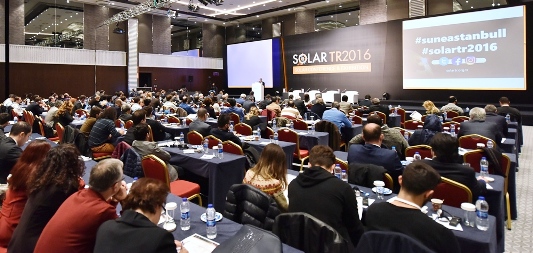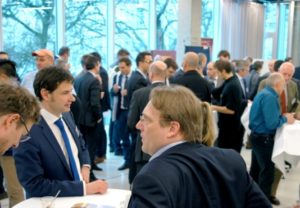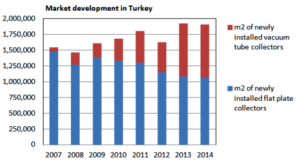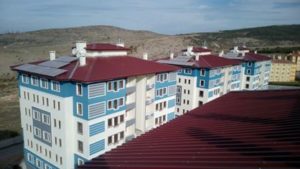Turkey: Over 1,000 Professionals Attend SolarTR 2016
January 20, 2017
The biannual SolarTR 2016 conference attracted more than 1,000 national and international solar energy stakeholders to Istanbul, Turkey, between 6 and 8 December 2016. The science- and technology-focused event showcased the development of PV technology across the country and around the globe and offered presentations in parallel sessions in Turkish and English, in particular about solar heating and cooling. “We had a dense programme with around 40 speakers in 9 different sessions and 14 keynote speeches dealing with the visions for and the strategic issues of solar energy applications, their opportunities and challenges,” said Kemal Gani Bayraktar, President of GÜNDER, the Turkish Solar Energy Society, and host and co-organiser of the conference in close collaboration with universities, industries, public institutions and non-governmental organisations.
Source: Günder
“Turkey has made great progress in the last two years. In addition to technological advances in solar electricity production, there have been improvements in the field of solar process heat and steam as well as with large solar heating and cooling systems,” Dr Bülent Yeşilata, Professor at the Engineering Faculty of Sanliurfa’s Harran University and Scientific Chair of SolarTR, said in his closing speech.
The SHC part of the conference programme included training sessions on centralised and large solar hot water systems, energy labelling, and testing and certification. A highlight for attendees interested in solar heating and cooling was the session titled Emerging Opportunities in Solar Thermal Energy Applications, during which Dr Hasan Sencer Peker, Lecturer at Gazi University, gave an overview of the Turkish solar thermal market, followed by presentations from large industry players.
Peker emphasised that Turkey’s around 18 million m² of collector area in operation saved around 10 % of the yearly natural gas consumption. He said that this share could be increased to around 38 million m² by 2030, to meet around 20 % of the country’s gas demand if all government bodies – such as ministries, schools, etc. – increased awareness and convinced the public of the technology. He added that it was in the government’s own interest to increase the deployment of local solar technologies, as 20 % of Turkish imports were spent on energy sources.
The plan which Peker presented included the following recommendations for action:
- Create a Statistics and Information Centre for the Turkish market
- Implement Standardisation and Certification of products
- Enforce Regulations on building / construction
- Implement a subsidy scheme
- Find remedies against the shadow market
- Substitute imports of intermediate products (e.g., absorbers with selective coatings)
Drivers-Barriers Analysis
“Around 10 large firms have a combined market share of 40 %; unregistered small producers make up the remaining 60 %,” is how Peker described the supply industry and its estimated annual production capacity of 1.2 million m².
He also presented the results of a Drivers-Barriers Analysis of the Turkish solar thermal industry and market in a four-part table (see below).
| Drivers | Barriers |
Strengths
|
Weaknesses
|
Opportunities
|
Risks
|
SolarTR 2016 has set new standards in terms of global participation by experts, as its organisers offered a live presentation broadcast watched by more than 10,000 people in 11 different countries. A selection of abstracts and entire documents can be found as part of the proceedings, which are available as a PDF online. http://solartr.org.tr/files/PROCEEDINGS-SOLAR-TR2016.pdf. The next SolarTR conference and exhibition will be held in 2018.
Websites of organisations mentioned in this article:


